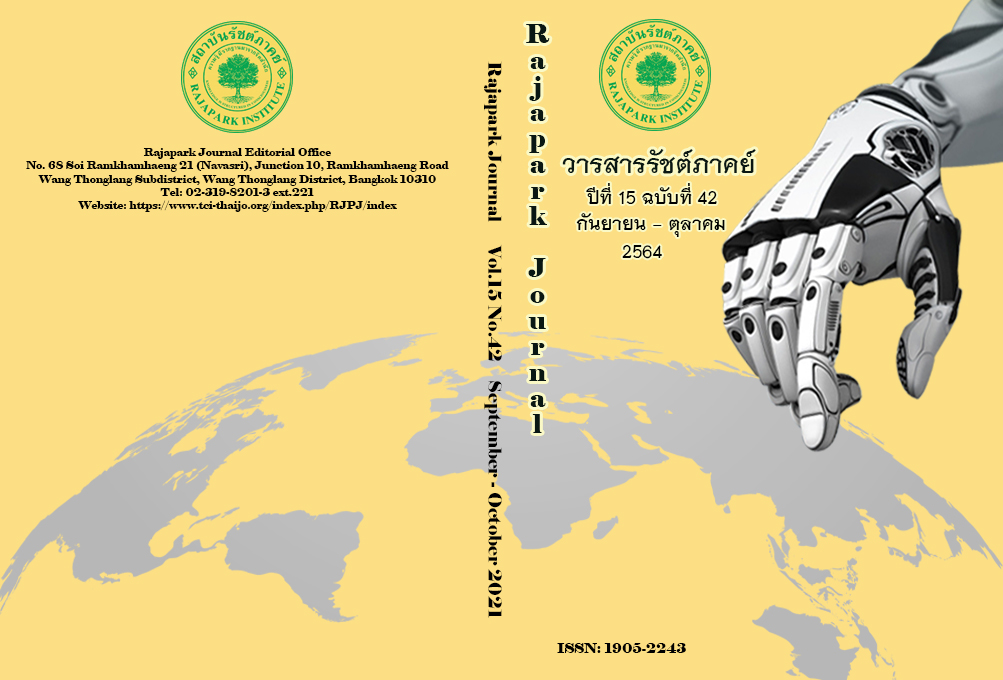Logistic Regression Analysis Application in Financial Efficiency Prediction of Equity Mutual Fund in Thailand
Main Article Content
Abstract
This study has been conducted to construct an efficient financial prediction model and to examine factors affecting the prediction of equity mutual funds in Thailand. This study has adopted and applied the Logistic Regression (LOGIT) of Bankruptcy Prediction, including 274 equity mutual funds samples, each with the maturity of 5 years, and was conducted from 2016 to 2020. The financial efficiency was determined by both the fund’s outperformance and underperformance compared with the SETTRI market index in three performance measurements: Sharpe, Treynor, and Jensen’s alpha. The internal factors consist of financial ratios and fund-specific factors, while the external factors are Gross Domestic Product Growth (GDP Growth). The results from the study revealed that the LOGIT prediction model based on Jensen’s Alpha performed the highest accuracy one year before financial efficiency. It correctly predicted 73.6 percent. In addition, the total asset turnover and fund age statistically significantly affected financial efficiency in all measurements. The study results have confirmed the importance of financial ratios in the prediction model. Moreover, the financial efficiency prediction, which is adopted from the Logistic Regression (LOGIT) of Bankruptcy Prediction, is suggested for further study on another type of mutual fund.
Article Details
Views and opinions appearing in the Journal it is the responsibility of the author of the article, and does not constitute the view and responsibility of the editorial team.
References
Altman, E. (1968). Financial Ratios, Discriminant Analysis and the Prediction of Corporate Bankruptcy. Journal of financial, 23(4), 589-609.
Association of Investment Management Companies [AIMC]. (2021a). Data and Statistics. Retrieved from http://ns3.aimc.or.th/web/
Association of Investment Management Companies [AIMC]. (2021b). Ratio of Mutual Fund Accounts to Number of Deposit Accounts 1997-2019. Retrieved from http://oldweb.aimc.or.th/21_overview_detail.php?nid=9& subid=0&ntype=2
Balcaen, S., & Ooghe, H. (2006). 35 Years of Studies on Business Failure: An Overview of the Classic Statistical Methodologies and their Related Problems. The British Accounting Review, 38, 63–93.
Bank of Thailand. (2021). Interest Rates in Financial Market (2005- present). Retrieved from https://www.bot.or.th/App/BTWS_STAT/statistics/BOTWEBSTAT.aspx?reportID=223&language=TH
Beaver, W. H. (1966). Financial Ratios and Predictors of Failure. Journal of Accounting Research, 4, 71-111.
Danrattanachai, P. (2020). Risk, Return and Financial Performance Comparison between Infrastructure Fund and Energy & Utility Common Stock Investment(Master of Business Administration). Kasetsart University.
Ferreira, M. A., Miguel, A. F., & Ramos, S. (2006). The Determinants of Mutual Fund Performance: A Cross-Country Study. ISCTE Business School. Swiss Finance Institute Research Paper Series 6-31, Swiss Finance Institute.
Jaisean, N. (2016). Bankruptcy Prediction of the Listed Company in Market for Alternative Investment (MAI) of Thailand(Master of Business Administration). Thammasat University.
Jensen, M. C. (1967). The Performance of Mutual Funds in the Period 1945-1964. Journal of Finance, 23(2), 389-416.
Jumpee, P. (2015). Predicting Economic Failure in the Thai Insurance Industry(Master of Business Administration). Thammasat University.
Markowitz, H. (1959). Portfolio Selection-Efficient Diversification of Investments. New York: Wiley.
Nguyen, H., & Nguyen, Dung, T. T. (2019). The Impact of Country-level and Fund-level Factors on Mutual Fund Performance in Vietnam. Journal of Economics and Development, 21(1), 42-56. DOI:10.1108/jed-06-2019-0007
Ohlson, J. A. (1980). Financial Ratios and the Probabilistic Prediction of Bankruptcy. Journal of Accounting Research, 18(1), 109-131.
Pilasri, P., & Phadoongsitthi, M. (2011). Bankruptcy Prediction Model Using Discriminant Analysis. Journal of Accounting Profession, 7(18), 26-42.
Rehman, A., & Baloch, Q. B. (2016). Factors Affecting Mutual Fund Performance in Pakistan: Evidence from Open Ended Mutual Funds. Abasyn Journal of Social Sciences, 9(2), 211-219.
Sharpe, W. F. (1966). Mutual Fund Performance. Journal of Business, 39(1), 119-138.
Sukcharoensin, S., & Sukcharoensin, P. (2013). Persistence of Equity Mutual Fund Performance in Thailand. NIDA Economic Review, 7(2), 101-132.
Thamrongrakkul, S. (2008). A Comparative Study of Performance and Factors Determining Return of Property Fund in Thailand [Property Fund](Master of Business Economics). Thammasat University.
Washiramontree, N., & Suwanna, T. (2019). The Relationship Between Financial Ratios and Stock Returns of Thai Listed Companies: A Case Study of Information and Communications Technology Sector. Pathumthani University Academic Journal, 11(1), 69-80.
WealthMagik. (2021). Fund Information. Retrieved from https://www.wealthmagik.com/FundInfo/Fund HouseList.aspx


